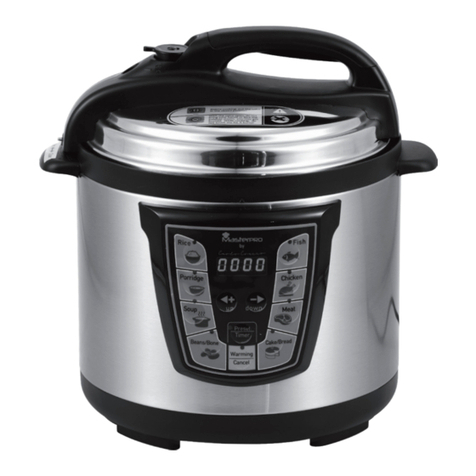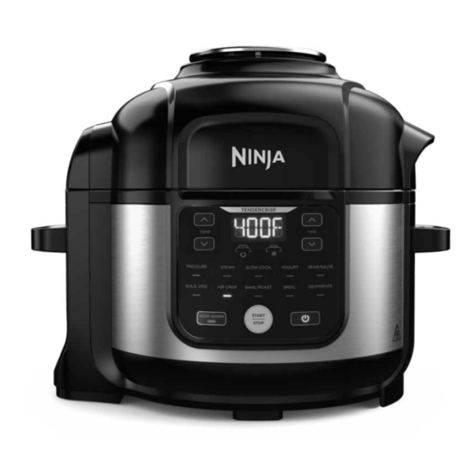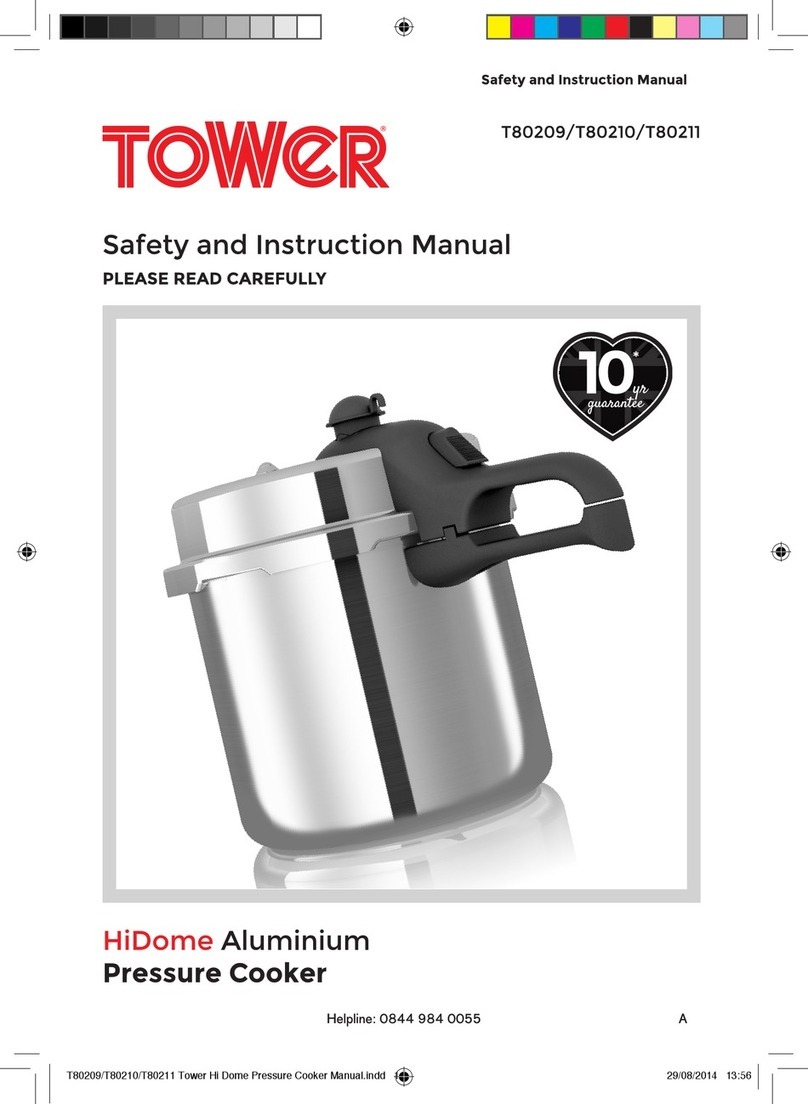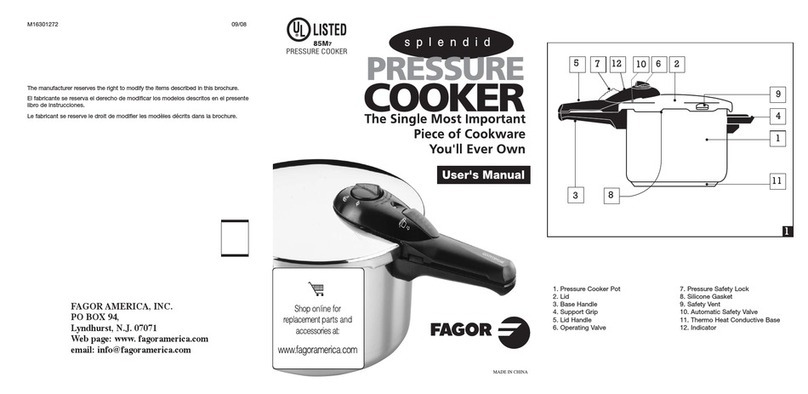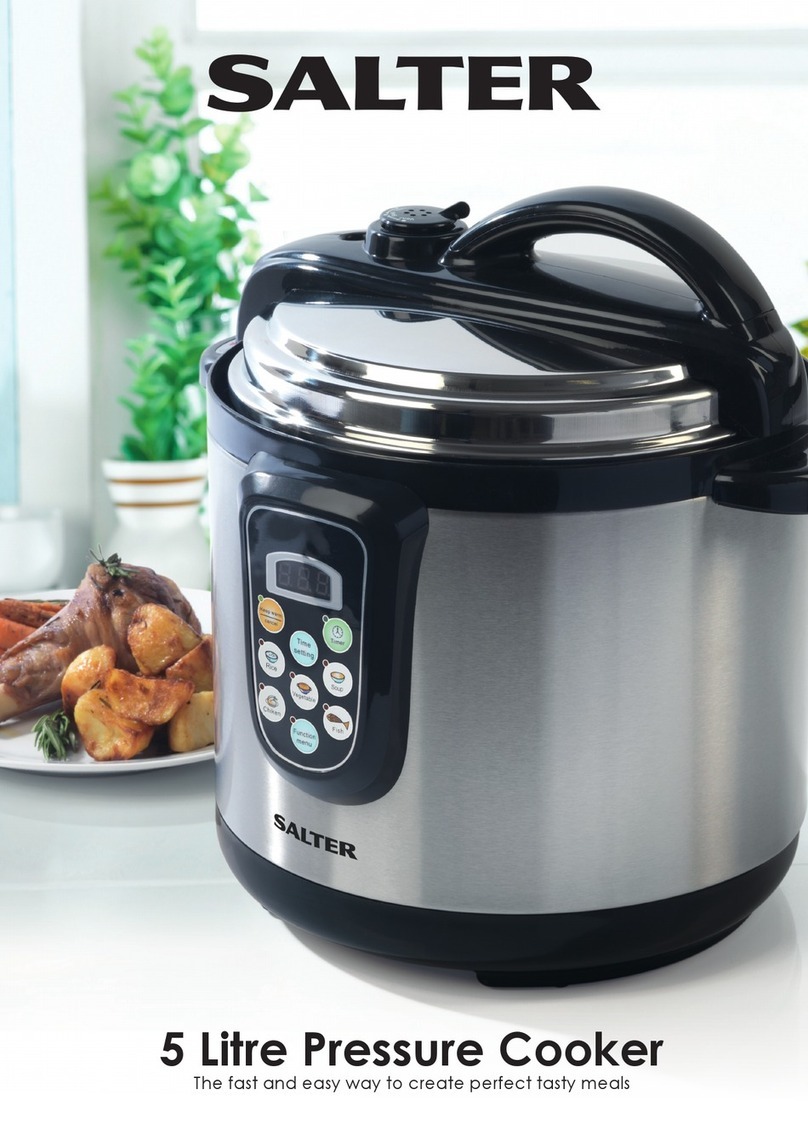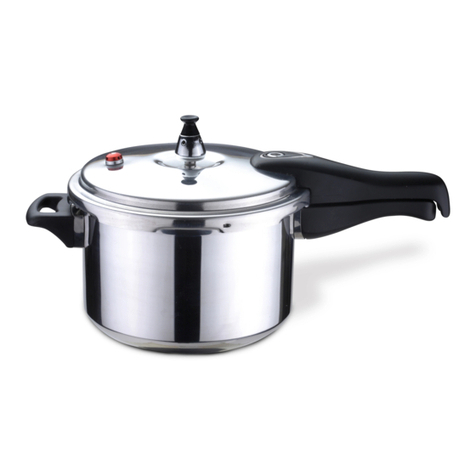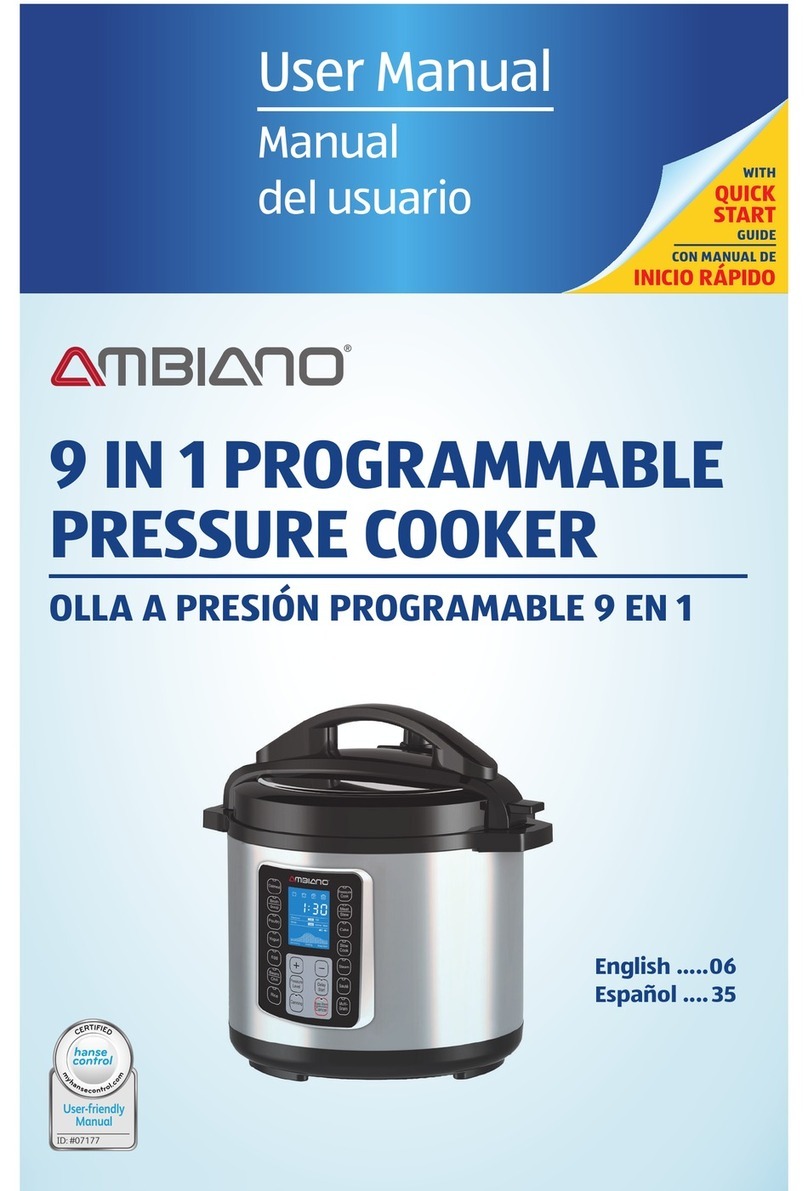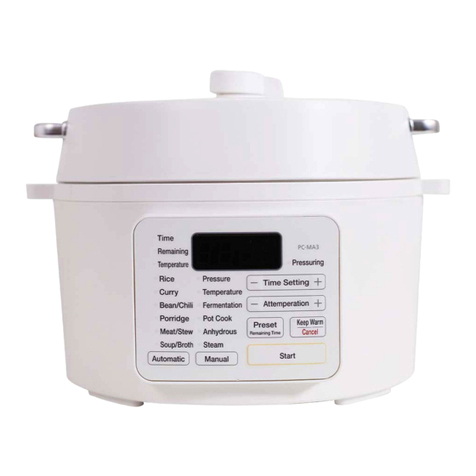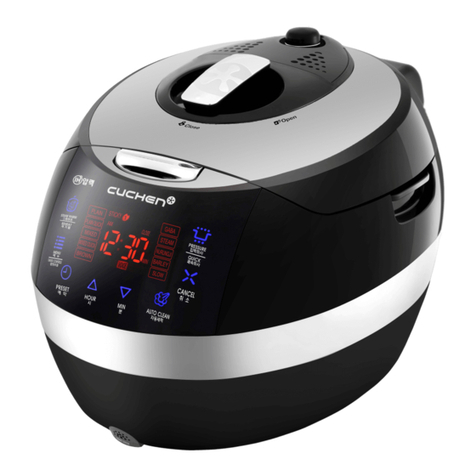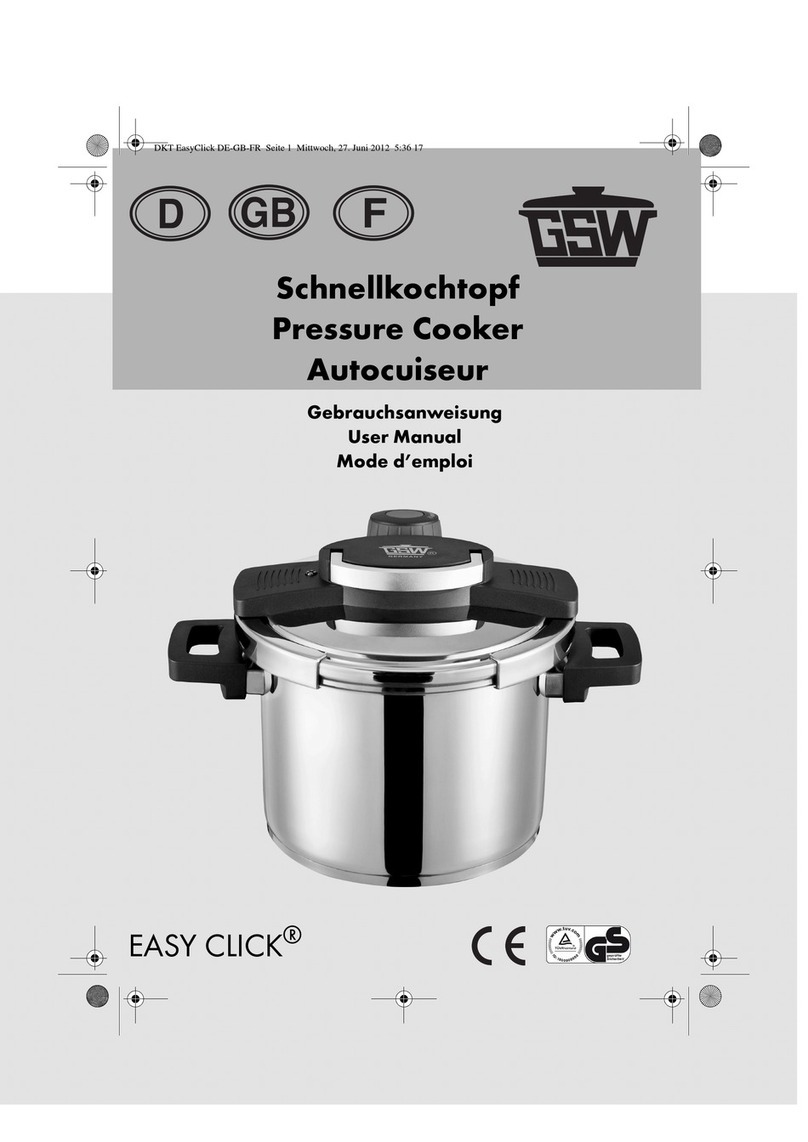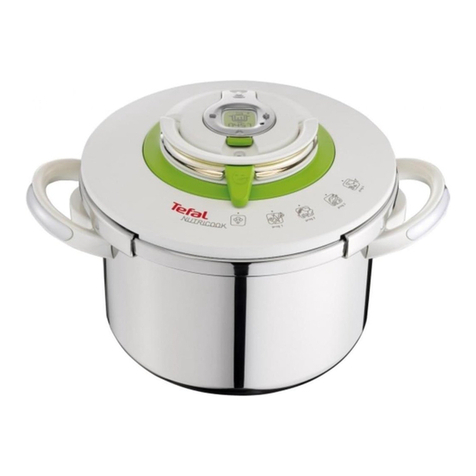Tescoma Bio exclusice+ User manual

Instructions for use and cooking in the pressure cooker
Návod k obsluze a vaření v tlakovém hrnci
Gebrauchsanleitung und Kochen im Schnellkochtopf
Mode d’emploi et cuisson dans la marmite à pression
Istruzioni per l‘uso e cucinare nella pentola a pressione
Instrucciones de uso y cocinar en la olla a presión
Instruções de utilização e cozedura na panela de pressão
Instrukcja obsługi i gotowanie w szybkowarze
Návod na použitie a varenie v tlakovom hrnci
Инструкция по эксплуатации и приготовление в скороварке

We congratulate you on the purchase of this Tescoma product. Thank you for buying Tescoma.
If needed, please contact your retailer or Tescoma at www.tescoma.com.
CHARACTERISTICS
The BIO EXCLUSIVE+ pressure cooker enables cooking at low or high pressure*, which contributes to
preserving the natural taste and nutritional value of meals. Cooking with the BIO EXCLUSIVE+ pressure
cooker is signicantly faster than standard cooking.
The BIO EXCLUSIVE+ pressure cooker is made of high-grade stainless steel,solid handles of high-
quality resistant plastic that do not burn if used properly.
The solid three-layer sandwich bottom has excellent heat retaining properties that help to economise
on energy. Cooking is faster and at a low heat output; the heat may be switched o in advance before
the end of cooking.
The pressure cooker is provided with 4 safety cut-outs - 3 independent high pressure cut-outs and
a lock against accidental opening; it is therefore entirely safe to use.
The BIO EXCLUSIVE+ pressure cooker is suitable for all types of cooker: gas, electric, vitro-ceramic and
induction cookers.
* OPERATING PRESSURES IN THE BIO EXCLUSIVE+ PRESSURE COOKER
The operating pressure in the vessel is 0.65 bar when cooking at low pressure.
The operating pressure in the vessel is 1.05 bar when cooking at high pressure.
PRESSURE COOKER DESCRIPTION
1 Operating valve
2 Pressure regulator
3 Safety valve with pressure indicator
4 Lock against accidental opening
5 Lid
6 Lid handle
7 Round marks for lid closing
8 Steam release / lid opening button
9 Aperture in the rim of the lid
10 Silicone seal
11 Vessel
12 Vessel and lid grips
13 Sandwich bottom
Pressure cooker BIO EXCLUSIVE+

BEFORE FIRST USE
Thoroughly study these instructions for use before the rst use. Wash the pressure cooker and all its parts
with warm water and detergent and wipe dry.
BEFORE EACH USE
Inspecting the valves (Fig. A, B, C, D, E, F, G)
Operating valve
Remove the pressure regulator by pulling it from the lid and make sure that its central part travels
freely up and down (Fig. A). Check visually that the aperture in the piston of the operating valve on
thelidisclean and not clogged (Fig. B). Otherwise ushit under runningwaterorcleanit using asuitable
object such as a thin skewer (Fig. C).
Check if the nut of the operating valve on the bottom of the lid is tight enough. If not, tighten the nut.
Attach the pressure regulator back to the lid handle after inspecting it, push the steam release button
several times and make sure that the pressure regulator freely travels up and down (Fig. D) and can be
easily set to the low and high pressure positions.
Safety valve
Push on the centre of the safety valve using a suitable object such as a thin skewer - it must spring
freely (Fig. E).
Then push the lock against accidental opening on the bottom of the lid grip away from the centre of the
lid and hold it - the safety valve on the bottom of the lid must travel freely up and down (Fig. F).
Check if the nut of the safety valve is tight enough; if not, tighten the nut.
Lock against accidental opening
Push the lock against accidental opening several times away from the centre of the lid -the lock
must spring (Fig. G).
INSPECTTHEVALVES ANDTHE LOCK BEFORE EACH USE OFTHE PRESSURE COOKER, APPLYING DUE CARE.
INSTRUCTIONS FOR USE
Opening the pressure cooker (Fig. H)
Push and hold the steam release / lid opening button, turn the lid counterclockwise and lift it o
the vessel.
NEVER APPLY INAPPROPRIATE FORCEWHEN OPENINGTHE PRESSURE COOKER.
Filling the pressure cooker (Fig. J)
FOR SAFETY REASONS,THE PRESSURE COOKER MUST BE FILLEDTO A MAXIMUM OF 2/3VESSEL CAPACITY.
Withfoodsthattendtofrothor swellwhen heated,suchas soups orlentils,rice,etc.,ll thepressurecooker
to a maximum of 1/2 vessel capacity to avoid unwanted clogging of valves and overboiling.
DO NOT COOKWITHOUTWATER INTHE PRESSURE COOKER.THE MINIMUM AMOUNT OFWATER IS 250ML.
Closing the pressure cooker (Fig. K)
Place the lid onto the vessel so that the round marks on the lid and on the handle of the vessel point
towards each other.Turn the lid clockwise so that the grips and the handles are aligned. Make sure
that the pressure regulator is inserted in the lid; if not, push it down lightly.

If the pressure cooker cannot be closed following the above description, check if the pressure indicator is
inserted in the lid grip. If not, push the lock against accidental opening away from the centre of
the lid - the pressure indicator will slip in automatically and the pressure cooker can be closed.
DO NOT APPLY INAPPROPRIATE FORCEWHEN CLOSINGTHE PRESSURE COOKER.
Cooking in the pressure cooker (Fig. L, M, N)
SELECT LOW OR HIGH PRESSURE BY SETTINGTHE REGULATORTOTHE RELEVANT POSITION.
If you wish to cook at1. a low pressure, turn the pressure regulator to the right.Cooking at
a low pressure is ideal for economic cooking of meals, for example for cooking vegetables, fruits,
sh, etc. (Fig. L).
If you wish to cook at2. a high pressure, turn the pressure regulator to the left. Cooking at
a high pressure is quicker and uses a higher temperature. It is suitable in particular for cooking
meat and meals that require longer thermal treatment (Fig. M).
Place the correctly lled and closed pressure cooker with the selected pressure onto a cooker set3. to the highest output.
Theredpressureindicatorplacedinthe lid grip4. willslip upwardsafter a short while.Thismeans that
the minimum pressure has been generated in the vessel and the pressure cooker can no longer be
opened - steam will begin to escape from the aperture in the pressure regulator after a while (Fig. N).
When steam begins to escape from the aperture in the pressure regulator, reduce the heat output5. so that only a small amount of steam escapes from the aperture in the pressure regulator.
6. We do not recommend changing the low / high pressure setting while cooking.
If this is necessary, use a7. kitchen mitten to control pressure during the cooking process!
WARNING! A MINUTE AMOUNT OF STEAM MAY ALSO ESCAPE FROM THE APERTURE BELOW THE LID GRIP
DURINGTHE COOKING PROCESS.
WARNING
Ifalarge amountof steam escapes fromthe pressurecookeratthe beginning ofthecookingprocess,the
pressure cooker has not been correctly closed. Incorrect closing is usually due to the following:
The lid is attached incorrectly - close the pressure cooker again.a)
The pressure regulator of the operating valve has slipped up to the steam release position - pushb) the pressure regulator downwards and set it to the low or high pressure cooking position.
The silicone seal is incorrectly positioned in the lid - check its position.c)
The silicone seal is faulty - replace it with a new originalTescoma seal.d)
Cooking termination, steam releasing and opening of the pressure cooker (Fig. O)
ALWAYS RELEASE STEAM ONLY AFTER REMOVINGTHE PRESSURE COOKER FROM HEAT.
After the time required for cooking your meal elapses, remove the pressure cooker from the heat
source even if the latter has already been switched o.
Set the pressure cooker aside for a while to allow the temperature and pressure in the pressure cooker
to drop suciently.
Then push the steam release button and hold it until all steam has escaped from the pressure
cooker (Fig. O). The pressure indicator will slip down automatically after the steam has been entirely
released and the pressure dropped; the pressure cooker can be opened now.

If the pressure indicator remains in the upper position and the pressure cooker cannot be opened, this
means that there is still pressure in the vessel. Pull the pressure regulator to the upper position
using an oven mitten and wait until all steam escapes from the pressure cooker.
If the pressure indicator does not slip in automatically even after the steam has been released and the
pressure cooker still cannot be opened, insert the pressure cooker into the sink and cool the lid with
a small amount of slowly running cold water until the pressure indicator slips in.
Then open the pressure cooker and thoroughly check and clean the operating valve and the safety
valve before further use.
NEVER COOL THE PRESSURE COOKER ABRUPTLY UNDER RUNNING WATER, DO NOT LET WATER RUN ONTO
PLASTIC PARTS AND DO NOT IMMERSETHE ENTIRE PRESSURE COOKER INWATER.
SAFETY CUT-OUTS
Operating valve
The operating valve controls the high and low pressure, continuously releases excess steam and
releases all steam from the pressure cooker at the end of cooking.
Safety valve
The safety valve operates as a backup activated when the operating valve becomes clogged.
Immediately remove the pressure cooker from the heat source if steam ceases to escape from the
operating valve and starts to escape intensely from the safety valve (the aperture under the lid grip) during
the cooking process. After the pressure cooker cools down, open it and clean the operating valve.
Aperture in the rim of the lid
If the operating valve and the safety valve become clogged simultaneously, the pressure in the pressure
cooker pushes the silicone seal through the aperture in the rim of the lid, which causes an immediate
drop in pressure and steam release.
Warning! When cooking, make sure that the aperture in the rim of the lid is not directed
towards individuals coming near the pressure cooker.
IF THE SILICONE SEAL IS PUSHEDTHROUGH THE APERTURE INTHE RIM OF THE LID, DO NOT REPAIR THE
PRESSURE COOKERYOURSELF; INSTEAD BRING IT IN FOR PROFESSIONAL SERVICING.
Lock against accidental opening
Prevents accidental opening of the pressure cooker until all steam has escaped from the vessel and
pressure drops entirely.
PRACTICAL RECOMMENDATIONS
ALWAYS USE AN APPROPRIATE SIZE OF COOKING RANGE OR FLAME FOR COOKING.
The diameter of the cooking range must be identical or smaller than the diameter of the bottom
of the pressure cooker! Flame must never expand beyond the bottom of the pressure cooker.Use
the dispenser net or cooking range when cooking on gas.
Make use of the heat retaining properties of the three-layer sandwich bottom. Switch the heat o in
advance before the end of cooking. Thanks to the three-layer sandwich bottom, the accumulated heat
energy is transferred into the pressure cooker even after the heat has been switched o.
The vessel of the pressure cooker without the lid may also be used as a traditional pot for cooking
meals on the cooking range.

STORAGE, MAINTENANCE and CLEANING
Lid
DO NOTWASHTHE LID OFTHE PRESSURE COOKER IN A DISHWASHER.
Clean the operating valve aperture by ushing it with running water or clean it using a suitable object
such as a thin skewer.
Clean the safety valve by repeatedly pulling it up under running water while simultaneously pushing
the lock against accidental opening away from the centre of the lid.
Do not disassemble the operating valve, the safety valve, the grips or any other parts of the lid.
STORE THE PRESSURE COOKERWITHTHE LID UNATTACHED.
Vessel
THEVESSEL OF THE PRESSURE COOKER IS DISHWASHER SAFE.
Shouldwhite stains due toscale formation appear inside the pressurecooker, use vinegar, lemon dropsor
the special stainless steel cleaning agent CLINOX to clean them.The white stains do not aect functioning
of the cookware and are not hazardous to health. As such they do not represent a fault and cannot be
claimed. When the cooker is overheated, purple to brown stains might appear on the surface. These
stains do not aect correct functioning of the cookware and are not hazardous to health. As such they do
not represent a fault and cannot be claimed.
Never expose the pressure cooker vessel to detergents including water-soluble detergents for prolonged
periods of time. Do not store remaining foods inside the vessel.
Silicone seal
Thepressurecookersealismade of excellentsiliconethatlasts for about 500 hours ofoperation.Remove
the seal from the lid after each use of the pressure cooker, wash it and dry, lightly smear with cooking
oil or fat and insert back.
If the seal shows any signs of leakage or loss of exibility, it must be immediately replaced with a new
Tescoma brand seal.
If you are not regularly using the pressure cooker, replace the seal regularly at two-year intervals.
ALWAYS USETESCOMA SPARE PARTS.
SAFETY INSTRUCTIONS pursuant to EN 12778
1. Read the INSTRUCTIONS FOR USE thoroughly before rst use.
2. Do not leave the pressure cooker unattended during the cooking process and do not use it for any
other purposes than cooking foodstus.
3. Check the operating valve and the safety valve for proper functioning prior to each use.
4. Handle the pressure cooker with utmost care when cooking; never touch the hot parts.
5. Prevent children coming near the pressure cooker while cooking.
6. Fillthe pressurecookertoamaximum of 2/3vesselcapacity;when cooking foods thattendtoswell
such as rice, lentils, pasta, etc., ll the pressure cooker to a maximum of 1/2 vessel capacity. Shake
the vessel before opening when cooking pasta in pressurised environment. Never cook without
water.
7. Donotputmealswrappedinfabric,paper orplasticmaterialsintothepressurecooker. Neverpierce
foods that tend to expand in volume (such as meat with skin, beef tongue, etc.) while the skin is
enlarged to avoid scalding.

8. Do not open the pressure cooker without entirely reducing pressure inside the vessel. Never apply
force when opening the pressure cooker.
9. Do not put the pressure cooker inside a heated oven and do not use it for frying.
10. Do not intervenein anysystemwithinthe pressurecookerbeyondthe Instructions foruse - contact
a professional service for repairs and use nothing other than original spare parts.
WARNING!
INTENDED FOR HEAT TREATMENT OF FOODS IN A PRESSURISED ENVIRONMENT. IMPROPER USE OR
MAINTENANCE CAN CAUSE INJURY!

HIGH PRESSURE
MEAT
Beef time in min
Roll 20-30
Roast beef 30-40
Sirloin 30-40
Soup meat 35-40
Tongue 45
Pork
Smoked side 20
Roll 20-30
Boiled pork knuckle 25-30
Roast 30-35
Veal
Roast 12-15
Head 15
Leg 15-20
Tongue 15-20
Lamb and mutton
Leg 30
Poultry
Squab 8-10
Chicken 15
Hen 15-20
Giblets 15
Venison
Rabbit 15
Roasted hare 15
Venison back 10
Hare on pepper 10-15
Venison leg 20-30
CEREALS
Oat and maize
Oat our 5
Oat akes 6
Gristles 6
Maize 10
LOW PRESSURE
FISH, FRUITS AND VEGETABLES
Fish time in min
Depending on amount 6-8
Potatoes
Sliced salted potatoes 7-9
Potatoes in their jackets 10-15
Fruit
Sliced apples 2-5
Sliced pears 2-5
Vegetables
Spinach 2-3
Pepper 3-4
Sliced celery 3-5
Sliced garlic 4
Broccoli 5-6
Sterilised beans 5-6
Kohlrabi 5-6
Carrot 6-8
Asparagus 6-10
Sprouts 8-10
Cabbage 7-12
Cut cauliower 8-9
Red cabbage 8-10
Sauerkraut 10-12
Whole cauliower 15-18
SOUPS AND LENTILS
Soups
Mushroom soup 2-5
Broth 25-30
Chicken bouillon 25-30
Oxtail 25-30
Lentils
Soaked peas 10-12
Soaked beans 25-30
RICE - LOW PRESSURE
Rice milk 7-8
Risotto 5-7
REFERENCE TIMES OF COOKING IN THE TESCOMA BIO EXCLUSIVE+ PRESSURE COOKER
The indicated times of cooking are measured from the moment steam begins to escape from the
operating valve. When this happens, set to low heat. All the indicated times are for reference only and
depend on the ingredients, their quantity, quality, initial temperature, type of heat source, individual
setting of pressure in the pressure cooker, etc. Deviations from the indicated times might occur; you will
determine accurate times based on your own experience.

WARRANTY CERTIFICATE
A 5-year warranty period applies to this product from the date of purchase. Present this warranty
certicate with a valid purchase receipt. Provision of the warranty does not prejudice the purchaser’s
rights applicable to the purchase under the special legal regulations. The warranty period commences
on the date of purchase.
Product:
Retailer (trade name and address):
Date of purchase:
Retailer’s stamp and signature:
The warranty does not cover:
- improper use of the product incompatible with the Instructions for use
- unauthorised repairs of and alterations to the product
- anything other than the original spare parts used in the product
- defects resulting from an impact or fall
- everyday wear and tear of the product, with the exception of obvious material defects
If you feel your complaints are justied, please contact your retailer or a Tescoma
servicing centre directly. For a current list of the servicing centres, please refer to
www.tescoma.com.
THE MANUFACTURER IS NOT LIABLE FOR ANY DAMAGE DUE TO HANDLING AND USING THE PRESSURE
COOKER AT VARIANCE WITH THESE INSTRUCTIONS FOR USE.

Blahopřejeme k zakoupení výrobku Tescoma a děkujeme za důvěru projevenou naší značce.
V případě potřeby se prosím obraťte na svého prodejce nebo na rmu Tescoma prostřednictvím
www.tescoma.com.
CHARAKTERISTIKA
Tlakový hrnec BIO EXCLUSIVE+ umožňuje vaření při nízkém nebo při vysokém tlaku*, což přispívá
k zachování přirozené chuti a nutričních hodnot pokrmů.Vaření v tlakovém hrnci BIO EXCLUSIVE+ probíhá
výrazně rychleji než standardní vaření.
Tlakový hrnec BIO EXCLUSIVE+ je vyroben z prvotřídní nerezavějící oceli, masivní rukojeti z kvalitních
odolných plastů, které při správném použití nepálí.
Masivní třívrstvé sendvičové dno má vynikající termoakumulační vlastnosti přispívající k úspoře
energie. Vaření probíhá rychleji a při nižším výkonu sporáku, který je možné vypínat s předstihem
ještě před ukončením vaření.
Tlakovýhrnecjevybaven4bezpečnostnímipojistkami-třeminasoběnezávislýmitlakovýmipojistkami
a pojistkou proti nechtěnému otevření; jeho použití je zcela bezpečné.
TlakovýhrnecBIOEXCLUSIVE+jevhodnýprovšechnytypysporáků:plynové,elektrické,sklokeramické
a indukční.
* PRACOVNÍ TLAKY V TLAKOVÉM HRNCI BIO EXCLUSIVE+
Pracovní tlak v nádobě při vaření při nízkém tlaku je 0,65 bar.
Pracovní tlak v nádobě při vaření při vysokém tlaku je 1,05 bar.
POPIS TLAKOVÉHO HRNCE
1 Pracovní ventil
2 Regulátor tlaku
3 Bezpečnostní ventil s indikátorem tlaku
4 Pojistka proti nechtěnému otevření
5 Poklice
6 Rukojeť poklice
7 Kulaté značky pro uzavírání poklice
8 Tlačítko vypouštění páry / otevření poklice
9 Otvor v lemu poklice
10 Silikonové těsnění
11 Nádoba
12 Úchyty nádoby a poklice
13 Sendvičové dno
Tlakový hrnec BIO EXCLUSIVE+

PŘED PRVNÍM POUŽITÍM
Před prvním použitím si důkladně prostudujte tento návod. Tlakový hrnec a všechny jeho části omyjte
teplou vodou s přídavkem saponátu a vytřete do sucha.
PŘED KAŽDÝM POUŽITÍM
Kontrola ventilů (A, B, C, D, E, F, G)
Pracovní ventil
Regulátor tlaku vyjměte vytažením z poklice a ujistěte se, že se jeho středová část volně pohybuje
nahoru a dolů (A). Zkontrolujte pohledem, zda je otvor v pístu pracovního ventilu v poklici čistý
– nezanesený (B). V opačném případě jej propláchněte pod proudem vody nebo pročistěte vhodným
předmětem, např. tenkou grilovací jehlicí (C).
Zkontrolujte, zda je matice pracovního ventilu na spodní straně poklice pevně utažená. Pokud tomu tak
není, matici dotáhněte.
Po kontrole nasaďte regulátor tlaku zpět do rukojeti poklice, několikrát stiskněte tlačítko pro vypouštění
páry a ujistěte se, že se regulátor tlaku volně pohybuje nahoru a dolů (D) a lze jej snadno nastavit do
polohy pro nízký i pro vysoký tlak.
Bezpečnostní ventil
Vhodným předmětem, např. tenkou grilovaní jehlicí, zatlačte na střed bezpečnostního ventilu - musí
volně pružit (E).
Poté zatlačte na pojistku proti nechtěnému otevření na spodní straně úchytu poklice směrem od
středu poklice a přidržte ji - bezpečnostní ventil na spodní straně poklice se musí volně pohybovat
nahoru a dolů (F).
Zkontrolujte, zda je matice bezpečnostního ventilu pevně utažena, pokud tomu tak není, matici
dotáhněte.
Pojistka proti nechtěnému otevření
Zatlačte několikrát na pojistku proti nechtěnému otevření směrem od středu poklice - pojistka musí
pružit (G).
KONTROLU VENTILŮ A POJISTKY PROVÁDĚJTE PŘED KAŽDÝM POUŽITÍM A VĚNUJTE JÍ NÁLEŽITOU
POZORNOST.
POUŽITÍ
Otevírání tlakového hrnce (H)
Stiskněte a přidržte tlačítko vypouštění páry / otevření poklice, poklicí otočte proti směru hodinových
ručiček a nadzvednutím ji sejměte z nádoby.
PŘI OTEVÍRÁNÍ TLAKOVÉHO HRNCE NIKDY NEPOUŽÍVEJTE NEPŘIMĚŘENOU SÍLU.
Plnění tlakového hrnce (J)
TLAKOVÝ HRNEC LZE Z BEZPEČNOSTNÍCH DŮVODŮ PLNIT MAXIMÁLNĚ DO 2/3 OBJEMU NÁDOBY.
U jídel, která během tepelného zpracování pění nebo bobtnají, např. polévky nebo luštěniny, rýže apod.,
plňte hrnec maximálně do 1/2 objemu nádoby, abyste zabránili nežádoucímu zanesení ventilů
a překypění.
VTLAKOVÉM HRNCI NEVAŘTE BEZ POUŽITÍVODY. MINIMÁLNÍ MNOŽSTVÍ VODY JE 250ML.

Uzavírání tlakového hrnce (K)
Poklicitlakovéhohrncepoložtenanádobutak,abykulatéznačkynapoklicianarukojetinádobysměřovaly
proti sobě. Poklicí otočte po směru hodinových ručiček, aby se úchyty a rukojeti kryly. Zkontrolujte,
že je regulátor tlaku zasunutý v poklici, v případě že tomu tak není, zatlačte jej zlehka dolů.
Pokud tlakový hrnec nelze výše popsaným způsobem uzavřít, zkontrolujte, zda je indikátor tlaku v úchytu
poklice zasunutý. Pokud tomu tak není, zatlačte pojistku proti nechtěnému otevření směrem od
středu poklice - indikátor tlaku se sám zasune a tlakový hrnec lze uzavřít.
PŘI UZAVÍRÁNÍ HRNCE NEPOUŽÍVEJTE NEPŘIMĚŘENOU SÍLU.
Vaření v tlakovém hrnci (L, M, N)
NÍZKÝ NEBOVYSOKÝTLAK ZVOLTE NASTAVENÍM REGULÁTORUTLAKU DO PŘÍSLUŠNÉ POLOHY.
Pokud si přejete vařit při1. nízkém tlaku, otočte regulátor tlaku doprava. Vaření při nízkém
tlaku je ideální pro šetrnou tepelnou úpravu pokrmů, např. při vaření zeleniny, ovoce, luštěnin,
ryb apod. (L).
Pokud si přejete vařit při2. vysokém tlaku, otočte regulátor tlaku doleva.Vaření při vysokém
tlaku je rychlejší a probíhá při vyšší teplotě. Hodí se zejména k přípravě masa a pokrmů, které
vyžadují delší tepelné zpracování (M).
Správněnaplněnýa uzavřenýhrnec se zvoleným tlakempostavtena sporáknastavenýna3. nejvyšší
stupeň.
Pokrátkéchvílise červenýindikátortlaku umístěnýv úchytupoklice4. vysune nahoru.To znamená,
že se v nádobě vytvořil minimální tlak a tlakový hrnec již nelze otevřít - pára začne po chvíli unikat
z otvoru v regulátoru tlaku (N).
Jakmile začne pára unikat z otvoru v regulátoru tlaku, snižte výkon sporáku tak, aby z otvoru5. regulátoru ucházelo jen malé množství páry.
Měnit nastavení nízkého nebo vysokého tlaku během vaření6. nedoporučujeme.
Pokud je to nutné, použijte při regulaci tlaku7. během vaření kuchyňskou rukavici!
POZOR! V PRŮBĚHU VAŘENÍ MŮŽE NEPATRNÉ MNOŽSTVÍ PÁRY UNIKAT TÉŽ Z OTVORU POD ÚCHYTEM
POKLICE.
UPOZORNĚNÍ
Pokud na počátku vaření z tlakového hrnce uniká velké množství páry, není tlakový hrnec správně
uzavřen. Nesprávné uzavření je obvykle způsobeno:
Poklice není správně nasazena - zopakujte uzavření hrnce.a)
Regulátor tlaku pracovního ventilu je vysunutý v poloze pro vypouštění páry - regulátor tlakub) zasuňte dolů a nastavte do polohy pro vaření při nízkém nebo vysokém tlaku.
Silikonové těsnění není správně osazeno v poklici - zkontrolujte jeho umístění.c)
Silikonové těsnění je poškozeno - vyměňte jej za nové originální těsnění značkyTescoma.d)
Ukončení vaření, vypouštění páry a otevírání tlakového hrnce (O)
PÁRU ZTLAKOVÉHO HRNCEVYPOUŠTĚJTEVŽDY AŽ PO JEHO ODSTAVENÍ ZE SPORÁKU.
Po uplynutí doby potřebné k uvaření pokrmů sejměte tlakový hrnec ze sporáku, a to i v případě, že je
sporák již vypnutý.
Tlakový hrnec ponechte chvíli odstavený, aby teplota a tlak v hrnci dostatečně poklesly.

Poté stiskněte tlačítko vypouštění páry a držte jej stisknuté tak dlouho, dokud z tlakového hrnce
neunikne veškerá pára (O). Indikátor tlaku se po úplném vypuštění páry a snížení tlaku sám zasune dolů
a tlakový hrnec je možné otevřít.
Pokud indikátor tlaku zůstává po vypuštění páry vysunutý v horní poloze a tlakový hrnec nelze otevřít,
znamená to, že je v nádobě stále tlak. S použitím kuchyňské rukavice povytáhněte regulátor tlaku
do horní polohy a vyčkejte, dokud všechna pára z hrnce neunikne.
Jestliže se indikátor tlaku ani po vypuštění páry sám nezasune a tlakový hrnec nelze nadále otevřít, vložte
tlakový hrnec do dřezu a ochlaďte poklici malým množstvím pomalu stékající studené vody, dokud
se indikátor tlaku nezasune.
Poté tlakový hrnec otevřete a před dalším použitím důkladně zkontrolujte a pročistěte pracovní
i bezpečnostní ventil.
TLAKOVÝ HRNEC POD TEKOUCÍ VODOU NIKDY NEOCHLAZUJTE ZPRUDKA, VODU NENECHTE STÉKAT NA
PLASTOVÉ ČÁSTI A HRNEC NENOŘTE DOVODY CELÝ.
BEZPEČNOSTNÍ POJISTKY
Pracovní ventil
Pracovní ventil reguluje nízký a vysoký tlak, průběžně vypouští přebytečnou páru a po ukončení vaření
vypouští z hrnce veškerou páru.
Bezpečnostní ventil
Bezpečnostní ventil funguje jako pojistka při zanesení pracovního ventilu. V případě, že během vaření
pára přestane unikat z pracovního ventilu a začne intenzivně unikat z bezpečnostního ventilu (otvoru pod
úchytem poklice), hrnec ihned odstavte. Po vychladnutí tlakový hrnec otevřete a vyčistěte pracovní ventil.
Otvor v lemu poklice
Pokud dojde k zanesení pracovního i bezpečnostního ventilu současně, tlak v hrnci vytlačí silikonové
těsnění otvorem v lemu poklice, čímž dojde k okamžitému snížení tlaku a úniku páry.
Pozor!Tlakový hrnec během vaření používejte tak, aby otvor v lemu poklice nebyl nasměrován
proti osobám v blízkosti tlakového hrnce.
POKUD DOJDE K PROTLAČENÍ SILIKONOVÉHO TĚSNĚNÍ OTVOREM V LEMU POKLICE, TLAKOVÝ HRNEC
SAMI NEOPRAVUJTE, ALE PŘEDEJTE JEJ DO ODBORNÉHO SERVISU.
Pojistka proti nechtěnému otevření
Zabraňuje nechtěnému otevření tlakového hrnce, dokud z nádoby neunikne všechna pára a nedojde
k úplnému snížení tlaku.
PRAKTICKÁ DOPORUČENÍ
KVAŘENÍVOLTE VŽDY ODPOVÍDAJÍCÍVELIKOST PLOTÝNKY NEBO PLAMENE.
Průměrplotýnkymusíbýtstejnýnebomenšínežjeprůměrdnahrnce! Plamennesmínikdypřesahovat
okraje dna hrnce.Při vaření na plynu používejte rozptylovací síťku nebo varnou plotýnku.
Využívejte termoakumulačních vlastností třívrstvého sendvičového dna. Sporák vypínejte s předstihem
ještě před ukončením vaření. Díky třívrstvému sendvičovému dnu je akumulovaná tepelná energie
předávána do hrnce i po vypnutí sporáku.
Nádobu tlakového hrnce bez poklice je možné využít i jako klasický hrnec pro přípravu pokrmů na
plotně sporáku.

SKLADOVÁNÍ, ÚDRŽBA a ČIŠTĚNÍ
Poklice
POKLICITLAKOVÉHO HRNCE NEMYJTEV MYČCE NÁDOBÍ.
Otvor pracovního ventilu čistěte propláchnutím pod proudem vody, případně jej vyčistěte vhodným
nástrojem, např. tenkou grilovací jehlicí.
Bezpečnostní ventil vyčistěte opakovaným povytažením pod tekoucí vodou při současném zatlačení
pojistky proti nechtěnému otevření směrem od středu poklice.
Pracovní ani bezpečnostní ventil, úchyty ani jiné části poklice nedemontujte.
TLAKOVÝ HRNEC SKLADUJTE VŽDY S NENASAZENOU POKLICÍ.
Nádoba
NÁDOBUTLAKOVÉHO HRNCE LZE MÝTV MYČCE NÁDOBÍ.
Objeví-li se uvnitř hrnce bílé usazeniny vodního kamene, vyčistěte je octem, několika kapkami citronu
nebospeciálnímprostředkemna čištěnínerezovéhonádobíCLINOX.Bíléskvrnynijakneomezujífunkčnost
či zdravotní nezávadnost nádobí, nejsou vadou výrobku a nemohou být předmětem reklamace. Při
přehřátí hrnce se na povrchu může objevit alové až hnědé zabarvení. Toto zabarvení neomezuje
funkčnost či zdravotní nezávadnost hrnce, není vadou výrobku a nemůže být předmětem reklamace.
Na nádobu tlakového hrnce nenechávejte nikdy dlouhodobě působit saponáty, a to ani vodou ředěné.
Uvnitř nádoby neskladujte zbytky pokrmů.
Silikonové těsnění
Těsnění tlakového hrnce je vyrobeno z prvotřídního silikonu a vydrží cca 500 hodin provozu. Po každém
použití tlakového hrnce vyjměte těsnění z poklice, umyjte jej, osušte, potřete lehce potravinářským
olejem nebo tukem a vložte zpět.
Pokudtěsněnívykazujejakékolivznámkynetěsnostinebo ztrátupružnosti, je třebajejokamžitěvyměnit
za nové těsnění značkyTescoma.
Pokud tlakový hrnec nepoužíváte intenzivně, měňte těsnění pravidelně v dvouletých cyklech.
POUŽÍVEJTE ZÁSADNĚ NÁHRADNÍ DÍLY ZNAČKYTESCOMA.
BEZPEČNOSTNÍ POKYNY dle EN 12778
1. Před prvním použitím si důkladně prostudujte NÁVOD K OBSLUZE.
2. Tlakový hrnec nenechávejte během vaření bez dozoru a nepoužívejte jej pro jiné účely, než k vaření
potravin.
3. Před každým použitím zkontrolujte funkčnost pracovního a bezpečnostního ventilu.
4. Během vaření manipulujte s tlakovým hrncem s maximální opatrností, nikdy se nedotýkejte jeho
horkých částí.
5. Zamezte dětem v přístupu do blízkosti tlakového hrnce během vaření.
6. Tlakový hrnec plňte maximálně do 2/3 objemu nádoby, při přípravě pokrmů, které vařením
bobtnají, jako jsou rýže, luštěniny, těstoviny apod., plňte tlakový hrnec max. do 1/2 objemu
nádoby.Přivařenítěstovinpod tlakemuzavřenýmhrncempo úplném sníženítlaku předotevřením
zatřeste. Nikdy nevařte bez použití vody.
7. Do tlakovéhohrncenevkládejtejídlazabalená do tkaniny,papíru neboplastikovýchobalů. Pokrmy,
u kterých dochází ke zvětšení objemu (např. maso s kůží, hovězí jazyk apod.), nikdy nepropichujte,

dokud je kůže nabobtnalá - nebezpečí opaření.
8. Tlakový hrnec neotvírejte dřív, dokud zcela nesnížíte tlak uvnitř nádoby. Nikdy při otvírání hrnce
nepoužívejte sílu.
9. Tlakový hrnec nedávejte do vyhřáté pečící trouby a nepoužívejte ke smažení.
10. Nezasahujte do žádného systému hrnce nad rámec návodu k použití - opravu svěřte vždy
odbornému servisu, nikdy nepoužívejte jiné, než originální náhradní díly.
POZOR! SLOUŽÍ K TEPELNÉ ÚPRAVĚ POKRMŮ POD TLAKEM. NESPRÁVNÉ POUŽITÍ NEBO ÚDRŽBA MOHOU
ZPŮSOBIT PORANĚNÍ.

ORIENTAČNÍ ČASY PRO VAŘENÍ V TLAKOVÉM HRNCI TESCOMA BIO EXCLUSIVE+
Uvedené doby vaření jsou měřeny od okamžiku, kdy z pracovního ventilu začne unikat pára. V tom
okamžiku přepněte sporák na nízký výkon. Všechny uvedené časy jsou pouze orientační a jsou závislé
na druhu připravovaných surovin, jejich množství, kvalitě, výchozí teplotě, typu sporáku, individuálním
nastavení tlaku v hrnci apod. Odchylky od uvedených časů nejsou vyloučeny, přesné časy stanovíte
na základě vlastních zkušeností.
VYSOKÝTLAK
MASO
Hovězí maso čas v min.
Roláda 20-30
Pečeně 30-40
Svíčková 30-40
Polévkové maso 35-40
Jazyk 45
Vepřové maso
Uzený bůček 20
Roláda 20-30
Ovarové kolínko 25-30
Pečeně 30-35
Telecí maso
Pečeně 12-15
Hlava 15
Nožička 15-20
Jazyk 15-20
Jehněčí a skopové maso
Kýta 30
Drůbeží maso
Holoubě 8-10
Kuře 15
Slepice 15-20
Husí drůbky 15
Zvěřina
Králík 15
Zaječí pečeně 15
Srnčí hřbet 10
Zaječí na pepři 10-15
Srnčí kýta 20-30
OBILOVINY
Oves a kukuřice
Ovesná mouka 5
Ovesné vločky 6
Ovesná krupice 6
Kukuřice 10
NÍZKÝ TLAK
RYBY, OVOCE A ZELENINA
Ryby čas v min.
Dle velikosti porce 6-8
Brambory
Brambory krájené solené 7-9
Brambory ve slupce 10-15
Ovoce
Jablka krájená 2-5
Hrušky krájené 2-5
Zelenina
Špenát 2-3
Paprika 3-4
Celer krájený 3-5
Česnek krájený 4
Brokolice 5-6
Zavařené fazole 5-6
Kedlubny 5-6
Mrkev 6-8
Chřest 6-10
Růžičková kapusta 8-10
Hlávkové zelí 7-12
Květák dělený 8-9
Červené zelí 8-10
Kysané zelí 10-12
Květák celý 15-18
POLÉVKY A LUŠTĚNINY
Polévky
Houbová 2-5
Masovývývar 25-30
Slepičí vývar 25-30
Volská oháňka 25-30
Luštěniny
Namočený hrách 10-12
Namočené fazole 25-30
RÝŽE
Rýžová kaše 7-8
Rizoto 5-7

ZÁRUČNÍ LIST
Na tento výrobek je poskytována záruční doba 5 roků ode dne prodeje. Tento záruční
list předkládejte s platným potvrzením o zakoupení výrobku. Poskytnutím záruky
nejsou dotčena práva kupujícího, která se ke koupi věci váží podle zvláštních právních předpisů. Záruční
doba začíná dnem prodeje.
Výrobek:
Prodejce (obchodní název a adresa):
Datum prodeje:
Razítko a podpis prodejce:
Záruka se zásadně nevztahuje na tyto případy:
- výrobek byl používán v rozporu s Návodem k obsluze
- na výrobku byly provedeny neautorizované opravy a změny
- na výrobku byly použity jiné než originální náhradní díly
- závady byly způsobeny úderem či pádem
- výrobek byl opotřebován běžným užíváním, kromě zjevných materiálových vad
Oprávněnou reklamaci uplatňujte u prodejce, u kterého jste výrobek zakoupili nebo
přímo v servisních střediscích Tescoma. Aktuální seznam servisních středisek na
www.tescoma.com.
VÝROBCE NEODPOVÍDÁ ZA JAKÉKOLIV ŠKODY ZPŮSOBENÉ MANIPULACÍ A POUŽITÍM TLAKOVÉHO HRNCE
V ROZPORU STÍMTO NÁVODEM K POUŽITÍ.

Wir gratulieren zum Kauf des Produktes Tescoma und danken für Ihr in die Marke gezeigtes
Vertrauen. Im Bedarfsfall wenden Sie sich bitte an Ihren Händler, bzw. na die Firma Tescoma
über www.tescoma.com.
BESCHREIBUNG
Der Schnellkochtopf BIO EXCLUSIVE+ ermöglicht das Kochen beim niedrigen oder beim hohen
Kochdruck*,wobei der natürliche Geschmack sowie der Nährwert der Speisen erhalten bleiben. Das
Kochen im Schnellkochtopf BIO EXCLUSIVE+ erfolgt erheblich schneller als der übliche Kochvorgang.
Der Schnellkochtopf BIO EXCLUSIVE+ ist aus erstklassigem rostfreien Edelstahl, die massiven Grien
dann aus hochwertigen festen Kunststoen hergestellt, die beim richtigen Gebrauch nicht heiß
werden.
Der massive dreischichtige Sandwich-Boden hat ausgezeichnete Wärmeleit-Eigenschaften, die
Energieersparnis bringen. Das Kochen erfolgt schneller und bei der niedrigeren Leistungsstufe, der
Kochherd kann ausgeschaltet werden, bevor das Gargut fertig gekocht ist.
Der Schnellkochtopf ist mit vier Sicherungen ausgestattet - 3 voneinander unabhängigen Sicherungen
und eine Sicherung gegen unbeabsichtigtes Önen; der Kochvorgang ist voll betriebssicher.
Der Schnellkochtopf Tescoma BIO EXCLUSIVE+ ist für sämtliche Herdarten geeignet: Gas-, Elektro-,
glaskeramische sowie Induktionsherde.
* ARBEITSDRUCKE IM SCHNELLKOCHTOPF BIO EXCLUSIVE+
Der Arbeitsdruck im Kochgefäß beim Kochen beim niedrigen Druck beträgt 0,65 bar.
Der Arbeitsdruck im Kochgefäß beim Kochen beim hohen Druck beträgt 1,05 bar.
BESCHREIBUNG DES SCHNELLKOCHTOPFES
Arbeitsventil1
Druckregler2
Sicherheitsventil mit Druckanzeiger3
Sicherung gegen unbeabsichtigtes Önen4
Deckel5
Deckelgri6
Runde Zeichen für Schließen des Deckels7
Knopf zum Dampfablass / Önen des Deckels8
Loch im Deckelrand9
Silikon-Dichtung10
Kochgefäß11
Grie des Kochgefäßes und des Deckels12
Sandwich-Boden13
Schnellkochtopf BIO EXCLUSIVE+

VOR DEM ERSTEN GEBRAUCH
VordemerstenGebrauchsorgfältigdieGebrauchsanleitungdurchlesen.DenSchnellkochtopfundsämtliche
Teile gründlich mit warmem Wasser mit Reinigungsmittel abwaschen und trockenwischen.
VOR JEDEM GEBRAUCH
Überprüfung der Ventile (A, B, C, D, E, F, G)
Arbeitsventil
Nehmen Sie den Druckregler aus dem Deckel heraus und überprüfen Sie, ob sich der Mittelteil frei
nachobenunduntenbewegt(A).ÜberprüfenSiedasLochimArbeitsventilkolbenaufdieVerstopfung
(B). Anderenfalls unter ießendem Wasser durchspülen, bzw. mit einem geeigneten Gegenstand wie z.B.
feine Grillnadel reinigen (C).
Überprüfen Sie, ob die Arbeitsventilmutter an der Unterseite des Deckels fest angezogen ist, bzw. sie fest
anziehen.
Nach der Überprüfung den Druckregler in den Deckelgri aufsetzen, mehrmals den Knopf für Dampfablass
betätigen und überprüfen, ob der Druckregler frei beweglich ist (D) und leicht in die Stellung für
niedrigen sowie hohen Druck eingestellt werden kann.
Sicherheitsventil
Mit einem geeigneten Gegenstand, z.B. mit feiner Grillnadel, die Mitte des Sicherheitsventils
herunterdrücken - es muss federn (E).
Dann die Sicherung gegen unbeabsichtigtes Önen auf der Unterseite des Deckelgries in der
Richtung aus der Deckelmitte herunterdrücken und gedrückt halten - das Sicherheitsventil auf der
Unterseite des Deckels muss frei beweglich sein (F).
Überprüfen Sie, ob die Sicherheitsventilmutter fest angezogen ist, bzw. sie fest anziehen.
Sicherung gegen unbeabsichtigtes Önen
Mehrmals die Sicherung gegen unbeabsichtigtes Önen in der Richtung aus der Deckelmitte betätigen
- die Sicherung muss federn (G).
VOR JEDEM GEBRAUCH SIND DIE VENTILE UND SICHERUNGEN BEI NÖTIGER AUFMERKSAMKEIT
ÜBERPRÜFEN.
GEBRAUCH
Önen des neuen Schnellkochtopfes (H)
Den Knopf zum Dampfablass / Önen des Deckels drücken und gedrückt halten, den Deckel gegen
Uhrzeigersinn umdrehen und vomTopf abnehmen.
BEIM ÖFFNEN DES SCHNELLKOCHTOPFES UNANGEMESSENE KRAFT NICHT ANWENDEN.
Befüllen des Schnellkochtopfes (J)
AUSDEN SICHERHEITSGRÜNDENKANN MANDEN SCHNELLKOCHTOPFMAX.ZU2/3 DESTOPFVOLUMENS
BEFÜLLEN.
Bei den Gerichten, die beim Kochen schäumen oder quellen, z.B. Suppen oder Hülsenfrüchte, Reis, usw., ist
der Schnellkochtopf max. zu 1/2 des Topfvolumens zu befüllen, um die unerwünschteVerschmutzung
derVentile, bzw. das Überlaufen zu vermeiden.
IM SCHNELLKOCHTOPF NIE OHNE WASSER KOCHEN. MIN.WASSERMENGE BETRÄGT 250ML.

Schließen des Schnellkochtopfes (K)
Den Deckeldes Schnellkochtopfesauf das Kochgefäßsetzen,wobeidierunden Zeichenaufdem Deckelund
auf dem Gri des Kochgefäßes gegenüberstehen sollen. Den Deckel im Uhrzeigersinn drehen, die
Grie des Kochgefäßes und die Grie des Deckels müssen miteinander passen. Überprüfen Sie, ob
der Druckregler im Deckel versenkt ist. Ist es nicht der Fall, müssen sie es leicht herunterdrücken.
Wenn der Schnellkochtopf wie beschrieben nicht geschlossen werden kann, bitte überprüfen, ob
der Druckregler im Deckel versenkt ist. Ist es nicht der Fall, betätigen Sie die Sicherung gegen
unbeabsichtigtes Önen in die Richtung aus der Deckelmitte - der Druckregler versenkt sich
automatisch und der Schnellkochtopf kann verschlossen werden.
BEIM SCHLIESSEN DES SCHNELLKOCHTOPFES NIE UNANGEMESSENE GEWALT ANWENDEN.
Kochen im Schnellkochtopf (L, M, N)
DER NIEDRIGE ODER HOHE DRUCK IST MIT DEM DRUCKREGLER IN DIE GEWÜNSCHTE POSITION
EINZUSTELLEN.
Wenn Siebeim1. niedrigen Druck kochenwollen,drehenSie den Druckreglernach rechts. Das
Kochen unter niedrigem Druck ist für schonende Zubereitung von Speisen ideal, z.B. Gemüse, Obst,
Hülsenfrüchte, Fisch usw. (L).
Wenn Sie beim2. hohen Druck kochen wollen, drehen Sie das Druckregler nach links. Das
Kochen unter hohem Druck ist schneller und erfolgt bei höherer Temperatur. Dieser Garvorgang
ist vor allem für Zubereitung von Fleisch und den Speisen geeignet, die länger gekocht werden
müssen (M).
Den richtig befüllten und verschlossenen Topf mit der gewünschten Druckstufe auf den auf die3. höchste Leistung eingestellten Kochherd stellen.
Nach einigen Minuten4. fährt der rote Druckregler im Deckelgri heraus. Das bedeutet, dass die
gewünschte Druckstufe im Topf erreicht ist und der Schnellkochtopf nicht mehr geönet werden
kann - Dampf tritt aus der Önung im Druckregler aus (N).
Tritt aus der Önung im Druckregler Dampf aus, den Kochherd herunterschalten, aus der Önung5. im Druckregler soll nur geringe Dampfmenge austreten.
Es ist6. nicht zu empfehlen, beim Kochen die eingestellte Druckstufe zu ändern.
Im Bedarfsfall während des Kochvorgangs den Druck mit einem7. Ofenhandschuh zu regelnd!
ACHTUNG! WÄHREND DES KOCHVORGANGS KANN EINE GERINGE DAMPFMENGE AUCH AUS DER
ÖFFNUNG UNTERHALB DES DECKELGRIFFS AUSTRETEN.
HINWEIS
Tritt vom Anfang des Kochvorgangs an große Dampfmenge aus dem Schnellkochtopf aus, ist der
Schnellkochtopf nicht richtig verschlossen. Dies ist auf folgende Ursachen zurückzuziehen:
Der Deckel ist nicht richtig aufgesetzt - denTopf wieder richtig schließen.a)
Der Druckregler des Arbeitsventils steht in der Stellung für Abdampfen - es ist in die gewünschteb) Position für Kochen unter niedrigem, bzw. hohem Druck einzustellen.
Die Silikon-Dichtung ist im Deckel nicht richtig angebracht - die Anbringung des Dichtungsringsc) überprüfen.
Die Silikon-Dichtung ist beschädigt - für einen neuen Original-Dichtungsring Tescomad) austauschen.
Table of contents
Languages:
Other Tescoma Electric Pressure Cooker manuals

Tescoma
Tescoma presto User manual
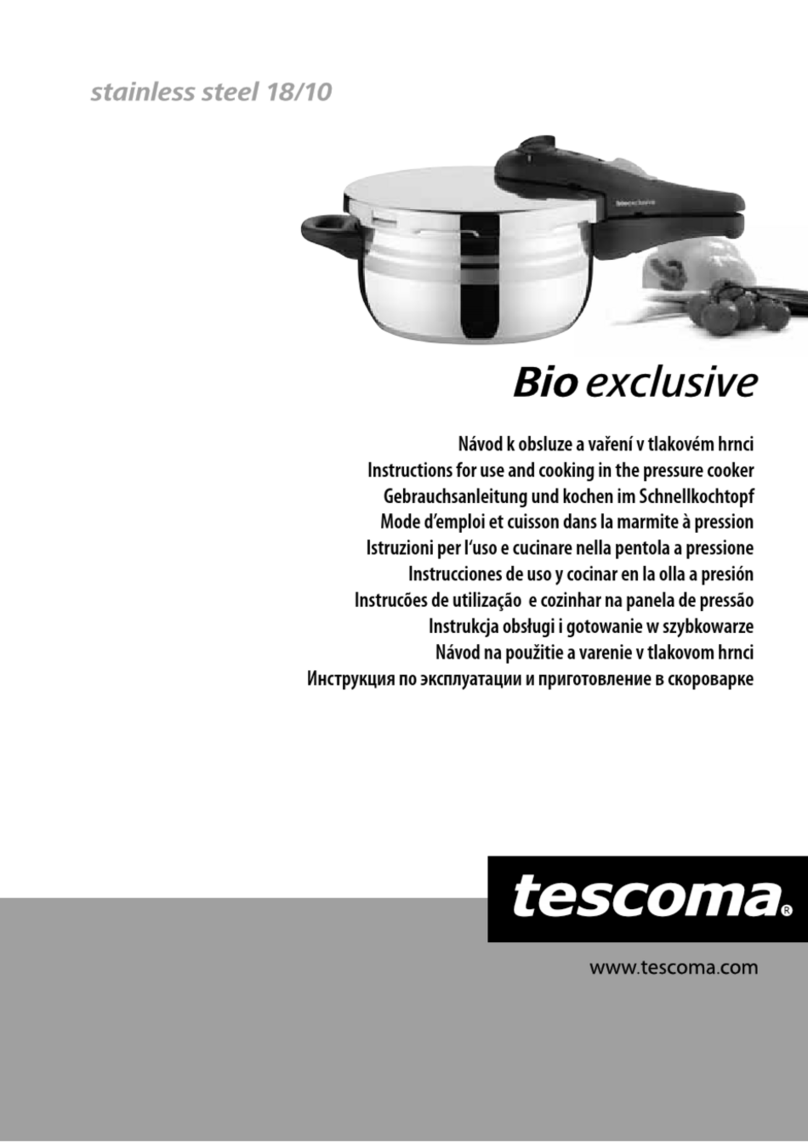
Tescoma
Tescoma Bio exclusive User manual
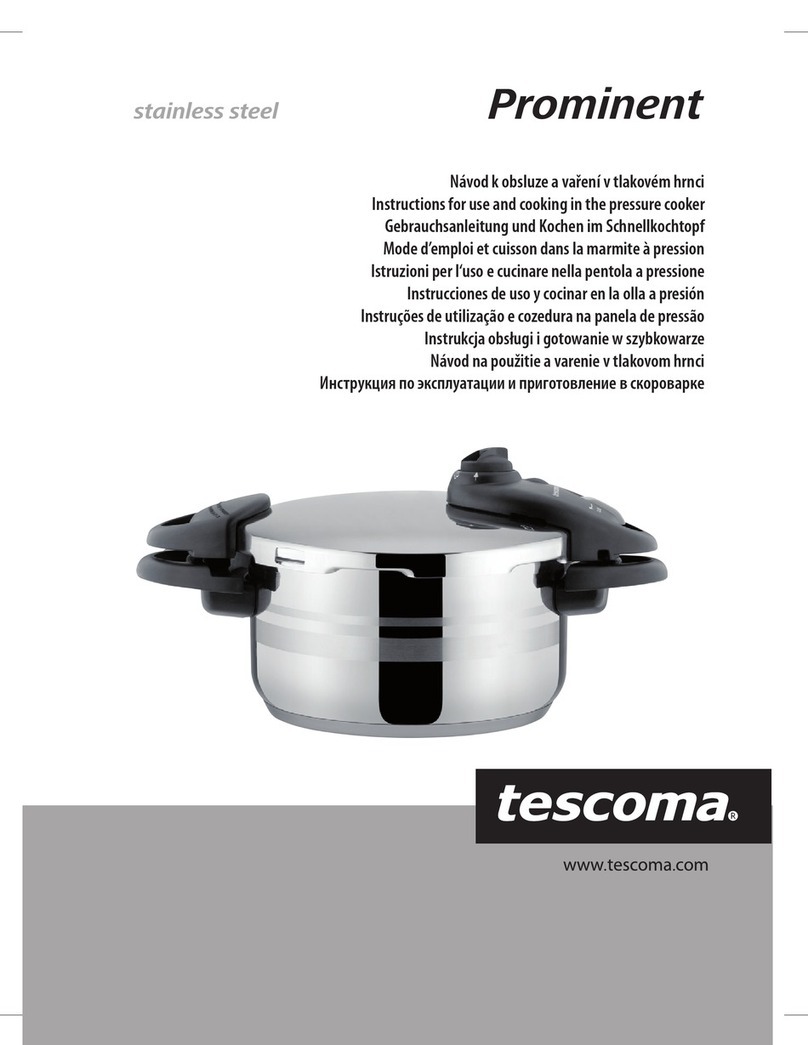
Tescoma
Tescoma Prominent User manual
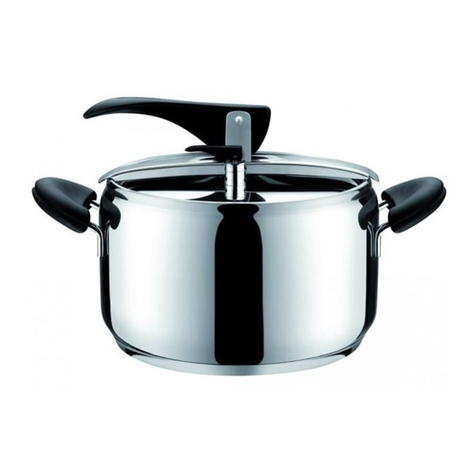
Tescoma
Tescoma MAGNUM User manual
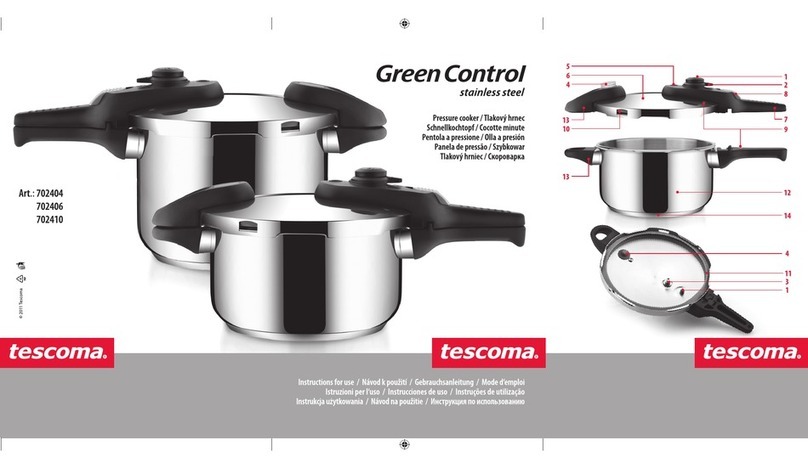
Tescoma
Tescoma 702404 User manual
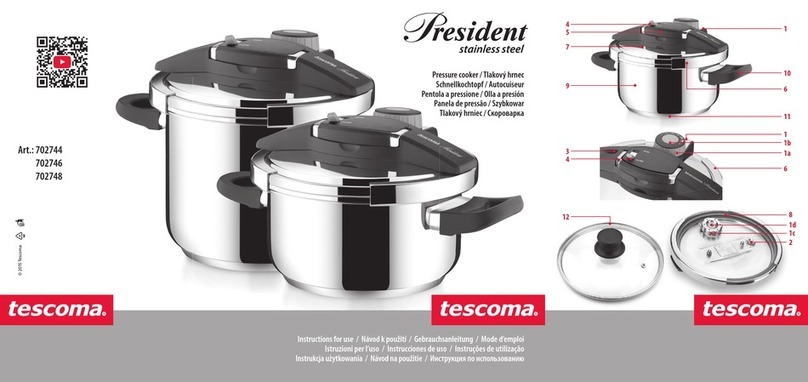
Tescoma
Tescoma President User manual

Tescoma
Tescoma Ultima Series User manual
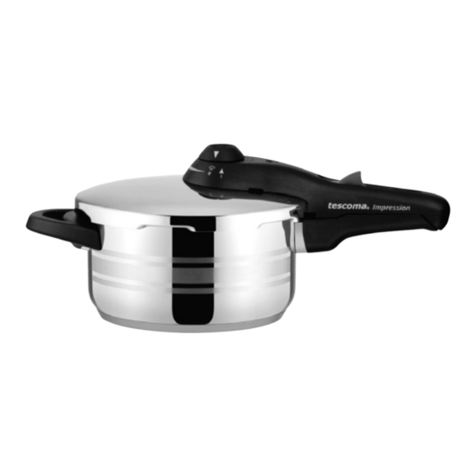
Tescoma
Tescoma IMPRESSION User manual
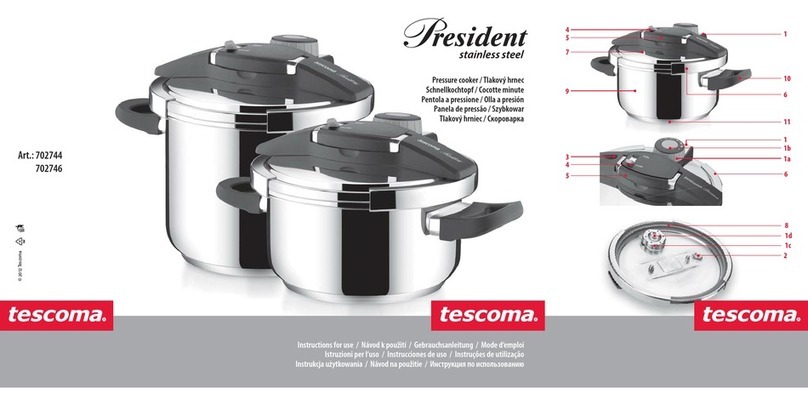
Tescoma
Tescoma President 702744 User manual
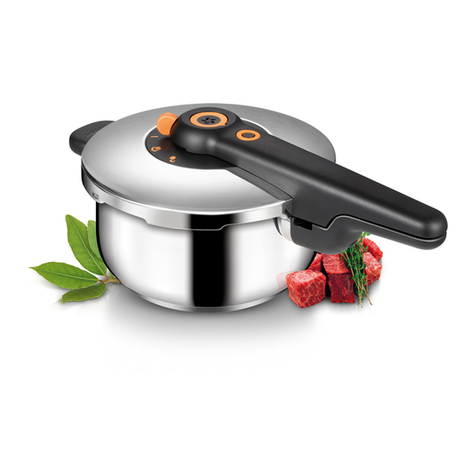
Tescoma
Tescoma SmartClick 702104 User manual

